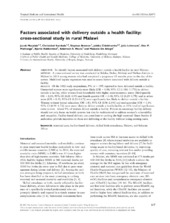| dc.contributor.author | Mazalale, Jacob | en_US |
| dc.contributor.author | Kambala, Christabel | en_US |
| dc.contributor.author | Brenner, Stephan | en_US |
| dc.contributor.author | Chinkhumba, Jobiba | en_US |
| dc.contributor.author | Lohmann, Julia | en_US |
| dc.contributor.author | Mathanga, Don P. | en_US |
| dc.contributor.author | Robberstad, Bjarne | en_US |
| dc.contributor.author | Muula, Adamson S. | en_US |
| dc.contributor.author | De Allegri, Manuela | en_US |
| dc.date.accessioned | 2016-03-29T10:50:57Z | |
| dc.date.available | 2016-03-29T10:50:57Z | |
| dc.date.issued | 2015-04-06 | |
| dc.Published | Tropical medicine & international health 2015, 20(5):617-626 | eng |
| dc.identifier.issn | 1365-3156 | |
| dc.identifier.uri | https://hdl.handle.net/1956/11756 | |
| dc.description.abstract | objective To identify factors associated with delivery outside a health facility in rural Malawi. method A cross-sectional survey was conducted in Balaka, Dedza, Mchinji and Ntcheu districts in Malawi in 2013 among women who had completed a pregnancy 12 months prior to the day of the survey. Multilevel logistic regression was used to assess factors associated with delivery outside a facility. results Of the 1812 study respondents, 9% (n = 159) reported to have delivered outside a facility. Unmarried women were significantly more likely [OR = 1.88; 95% CI (1.086–3.173)] to deliver outside a facility, while women from households with higher socio-economic status [third-quartile OR = 0.51; 95% CI (0.28–0.95) and fourth-quartile OR = 0.48; 95% CI (0.29–0.79)] and in urban areas [OR = 0.39; 95%-CI (0.23–0.67)] were significantly less likely to deliver outside a facility. Women without formal education [OR 1.43; 95% CI (0.96–2.14)] and multigravidae [OR = 1.14; 95% CI (0.98–1.73)] were more likely to deliver outside a health facility at 10% level of significance. conclusion About 9% of women deliver outside a facility. Policies to encourage facility delivery should not only focus on health systems but also be multisectoral to address women’s vulnerability and inequality. Facility-based delivery can contribute to curbing the high maternal illness burden if authorities provide incentives to those not delivering at the facility without losing existing users | en_US |
| dc.language.iso | eng | eng |
| dc.publisher | Wiley | eng |
| dc.rights | Attribution CC BY-NC-ND | eng |
| dc.rights.uri | http://creativecommons.org/licenses/by-nc-nd/4.0/ | eng |
| dc.subject | Maternal care | eng |
| dc.subject | Facility-based delivery | eng |
| dc.subject | Skilled birth attendance | eng |
| dc.subject | Malawi | eng |
| dc.subject | Sub-Saharan Africa | eng |
| dc.title | Factors associated with delivery outside a health facility: Cross-sectional study in rural Malawi | en_US |
| dc.type | Peer reviewed | |
| dc.type | Journal article | |
| dc.date.updated | 2015-12-29T14:30:40Z | |
| dc.description.version | publishedVersion | en_US |
| dc.rights.holder | Copyright 2015 the authors | |
| dc.identifier.doi | https://doi.org/10.1111/tmi.12473 | |
| dc.identifier.cristin | 1249395 | |
| dc.subject.nsi | VDP::Medisinske fag: 700::Helsefag: 800::Samfunnsmedisin, sosialmedisin: 801 | |
| dc.subject.nsi | VDP::Midical sciences: 700::Health sciences: 800::Community medicine, social medicine: 801 | |

